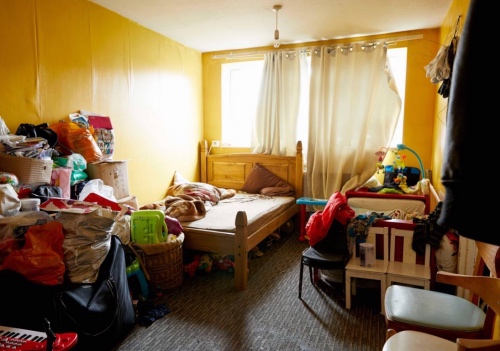A cot standing next to an overflowing kitchen sink; yellowing mouldy walls; a used mattress lying by a washing machine and bags of clothes – these rooms make up the homes of London’s poorest children.
A photo exhibition launched on Friday at the Foundling Museum depicts the living conditions of London’s 700,000 children living in poverty – defined by the government as household income below 60 per cent of UK median income in a given year.

A picture from the exhibition ‘Bedrooms of London’ shows the living conditions of children living in poverty across London. PICTURE: Courtesy of Katie Wilson
A shortage of social housing, rising rents and low wages create a “perfect storm” for families struggling to make ends meet, said Laurence Guinness, chief executive of the Childhood Trust, a child poverty charity involved in the exhibition.
“We hear a lot about housing, but rarely from a children’s perspective,” he told the Thomson Reuters Foundation.
Yet they are hardest hit by the country’s housing crisis, with many living in places that can “look more like a prison cell than a bedroom”, Guinness said.
More than 33,000 working families in Britain do not have a stable place to live, a 73 per cent rise from 2013, according to a study by the social housing commission of Shelter, a homelessness charity.
Shelter blamed rising private rents, a freeze on benefits and a shortage of social housing.
Katie Wilson, the London-based photographer behind the series, said that “people often think that if you have a roof over your head then you’re fine, box ticked.”
“But for many families that means being crammed in one room, children sleeping in the kitchen, having no space to do their homework,” she told the Thomson Reuters Foundation.
One of her pictures shows suitcases of clothes, a sewing kit and toiletries towering over an unmade bed – which Wilson said is shared by two parents and their toddler in South London.
Wilson said some aspects of precarious housing could not be seen or captured in a photograph.
“Think of constant noise, neighbours doing drugs, the anxiety of being a paycheck away from losing your home,” she said, adding that such living conditions could harm children’s physical and mental health as well as their education outcomes.
To address the problem, the government has pledged to spend £9 billion on building affordable homes, and has set an ambitious target of building 300,000 new homes a year by the mid-2020s.
A housing ministry spokeswoman said that “providing quality and fair social housing is a priority for the government”.
“All children deserve a bright future. That’s why, for families that need extra support, we are spending £90 billion a year on working-age benefits, and by 2022 we will be spending £28 billion more on welfare than we do now,” she said in emailed comments.





